MCP 技术解读
MCP 技术解读
- MCP概念、演进与意义
- MCP架构、核心组件与功能类型
- MCP Client 与 MCP Server
- 不同角色使用 MCP 的方式和逻辑
1. MCP是什么
MCP(Model Context Protocol) 是由 Anthropic(就是训练 Claude 的那个公司) 推出的一种新兴的标准开放协议,用于解决 Agent 平台的AI 模型与外部工具交互的痛点,帮助你在 LLM 之上构建智能体和复杂工作流。MCP 将应用程序向 AI 模型提供上下文的方式标准化,旨在通过安全的双向连接来增强 AI 模型与工具和数据源的交互能力。可以将 MCP 视为 AI 应用的 USB-C 接口,正如 USB-C 为设备连接各种外设和配件提供了标准化方式,MCP 也为 AI 模型连接不同数据源和工具提供了标准化方法。
MCP Server 就是为了实现 AI Agent 的自动化而存在的,它是一个中间层,告诉 AI Agent 目前存在哪些服务,哪些 API,哪些数据源,AI Agent 可以根据 Server 提供的信息来决定是否调用某个服务,然后通过 Function Calling 来执行函数。以前每个工具都要单独写代码才能连AI,但现在MCP就像"通用接口",工具和AI各装一个MCP插件,就能直接对话了。
比如要用Github服务,最终实现还是通过调用Github的API(https://api.github.com)来实现和Github交互,在调用 Github 官方的 API 之前,MCP 的主要工作是描述 Server 提供了哪些能力(给 LLM 提供),需要哪些参数(参数具体的功能是什么),最后返回的结果是什么。所以 MCP Server 并不是一个新颖的、高深的东西,它只是一个具有共识的协议。
官网:https://modelcontextprotocol.io/introduction
Github: https://github.com/modelcontextprotocol
2. AI 工具调用演进
从复杂提示词 → Function Calling → GPTs 插件 → MCP 协议的技术演进路径,非常类似于几个经典技术标准化的发展历程,特别是 Web 技术、互联网协议和 API 标准化的过程。以 Web API 的标准化进程类比,
| Web API 演进 | AI 工具调用演进 |
|---|---|
| 早期:RPC(远程过程调用)各自实现 | 早期:提示词工程中的工具调用 |
| 发展期:SOAP 和 XML-RPC 等框架 | 发展期:Function Calling 的 JSON 结构化调用 |
| 成熟期:REST API 成为主流 | 成熟期:GPTs 等平台专属实现 |
| 统一期:GraphQL 等新一代标准 | 统一期:MCP 作为统一协议 |
3. MCP 出来前后的区别是啥?意义是啥?
MCP 出来前后的区别
- MCP 出来前,Agent 平台需要自己维护可用工具列表以及进行工具调用
- Agent 平台集成 MCP 后,维护可用工具列表以及进行工具调用都由MCP来做
MCP意义
- MCP 解决了 Agent 平台工具调用标准不统一的问题,MCP Server 直接提供功能 API 作为 MCP 工具,供任意 Agent 平台直接使用,避免 Agent 平台重复造轮子,大幅降低开发成本
- MCP 通过标准化协议和客户端-服务器架构,提升了 AI 的上下文感知、自动化能力和安全性
- MCP 的客户端-服务器架构支持模块化扩展,一个客户端可连接多个服务器,Agent 平台可以轻松解锁多样化功能
4. MCP vs Function Calling
功能深度不同
- MCP: 连接层
- Function Calling: 执行层
- AI Agent: 决策层
应用场景不同
- MCP: 需要连接大量工具,但不想写代码
- Function Calling: 简单任务自动化
- AI Agent: 自主决策
5. MCP 架构
MCP 采用客户端-服务器架构
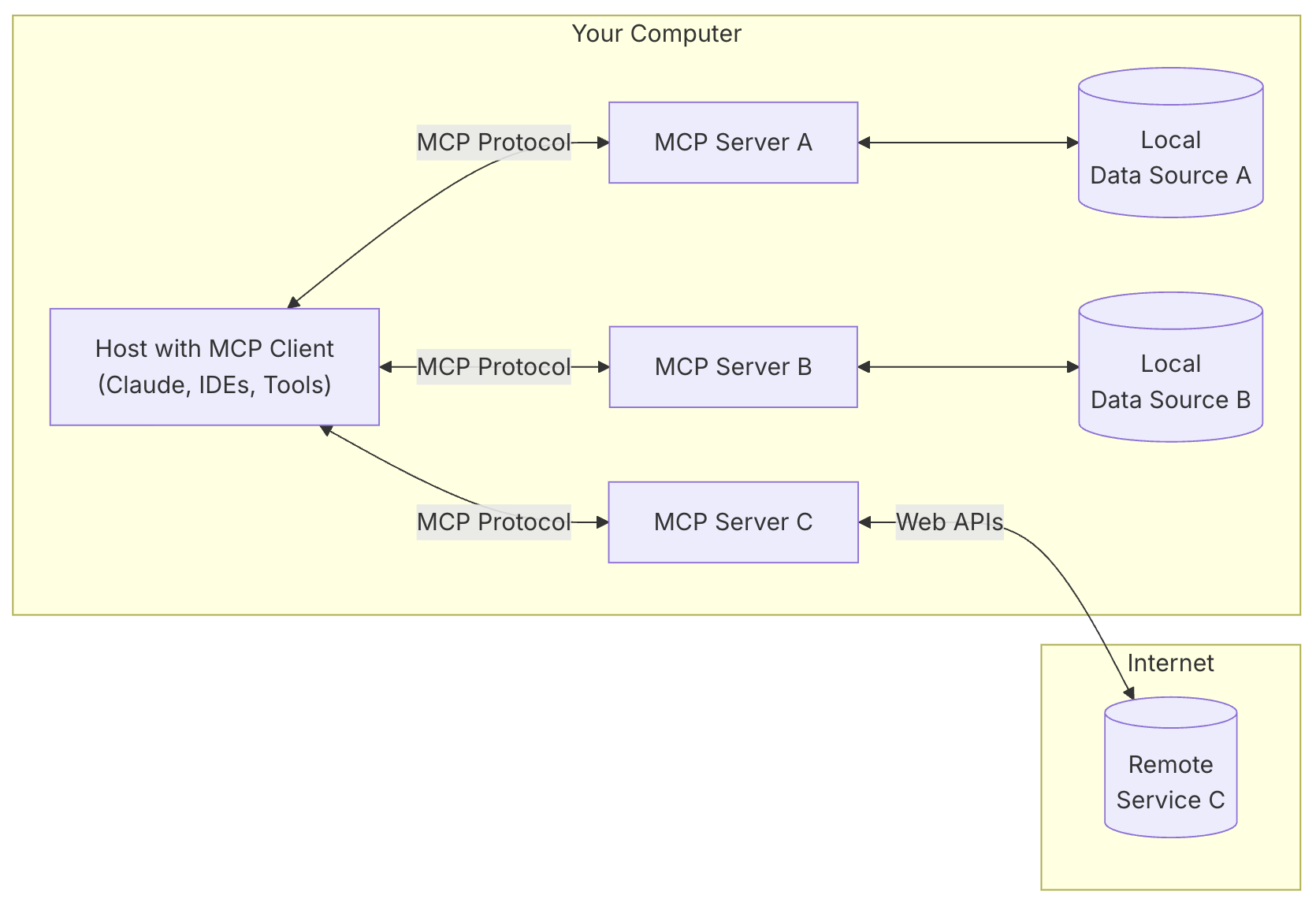
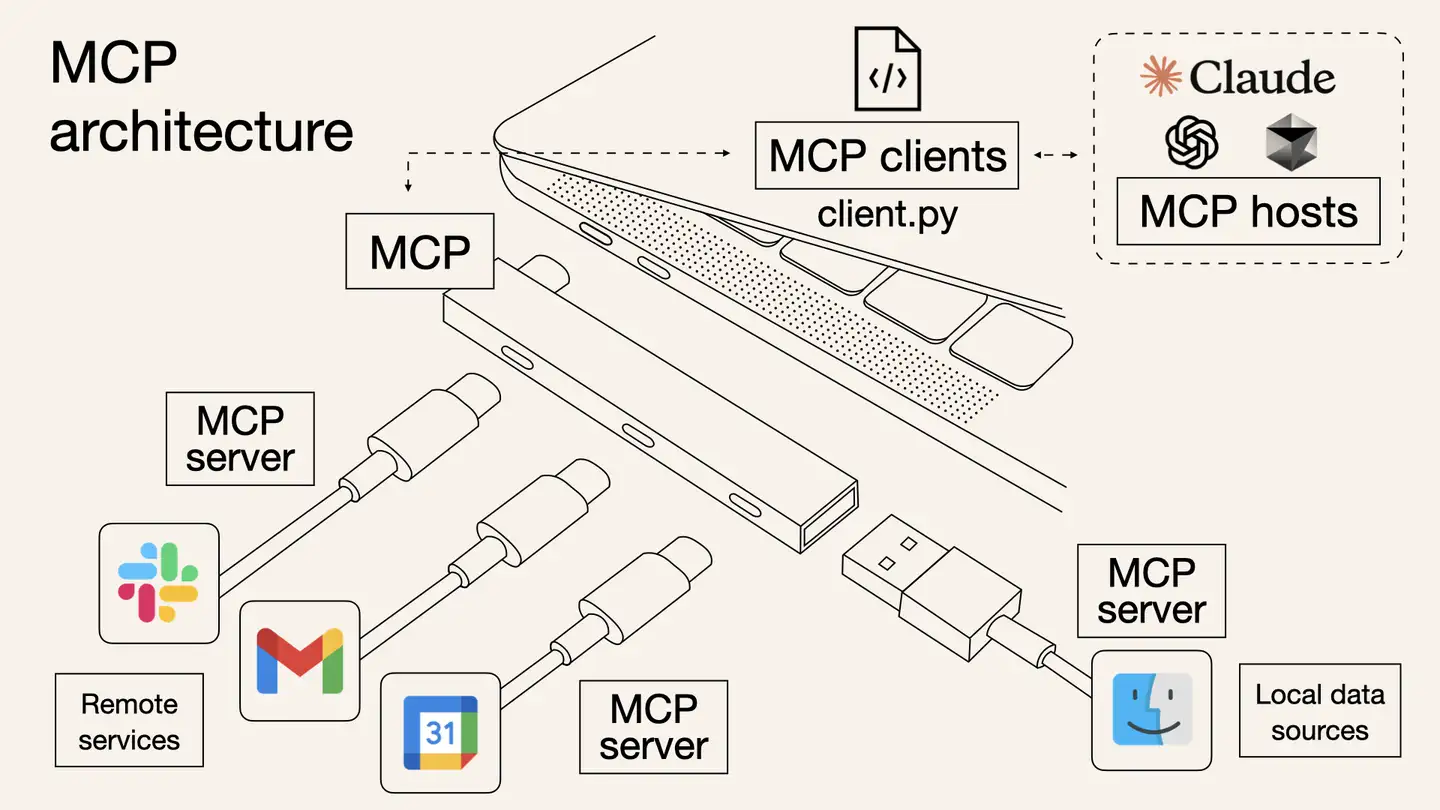
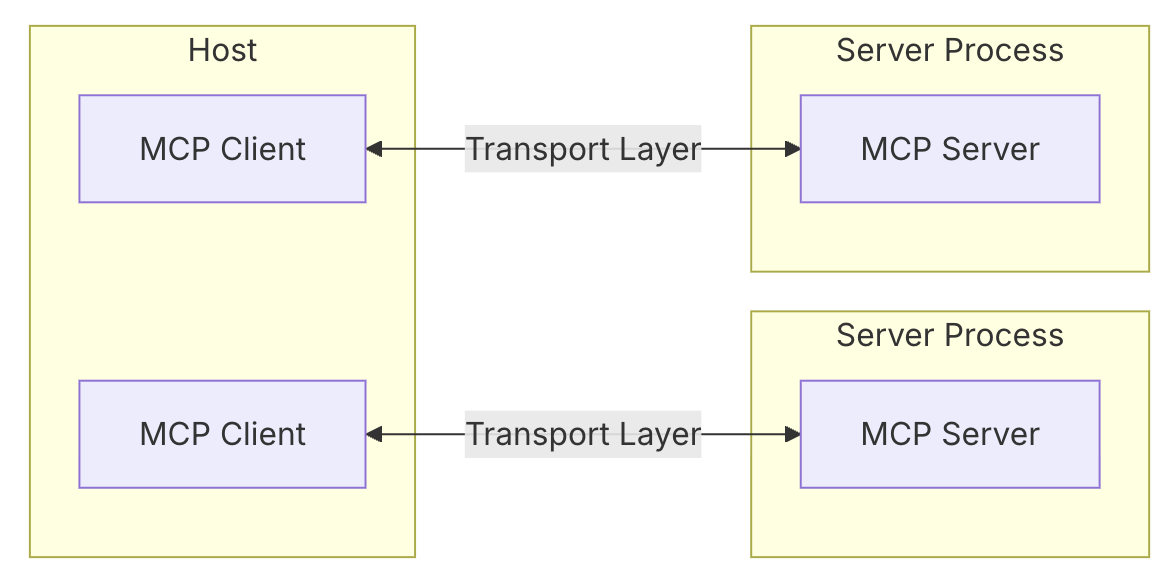
6. MCP 核心组件
核心组件
- Host 主机
- 是应用程序(如 Claude 桌面或 IDEs),它们发起连接
- Client 客户端
- 在主机应用程序内部与服务器保持 1:1 的连接
- Server 服务器
- 为客户端提供上下文、工具和提示
- Protocol layer 协议层
- 协议层处理消息封装、请求/响应链接和高级通信模式
- Transport layer 传输层
- 传输层负责处理 Client 和 Server 之间的实际通信
MCP 支持多种传输机制,所有传输都使用 JSON-RPC 2.0 来交换消息
- Stdio transport (标准输入输出传输)
- 使用标准输入/输出进行通信
- 适用于本地进程
- HTTP with SSE transport (使用 SSE 传输的 HTTP)
- 服务器到客户端的消息传输: 服务器发送事件方式(Server-Sent Events,SSE)
- 客户端到服务器的消息传输: HTTP POST方式
消息类型
- Requests
- Results
- Errors
- Notifications
7. MCP 连接生命周期
7.1. Initialization 初始化
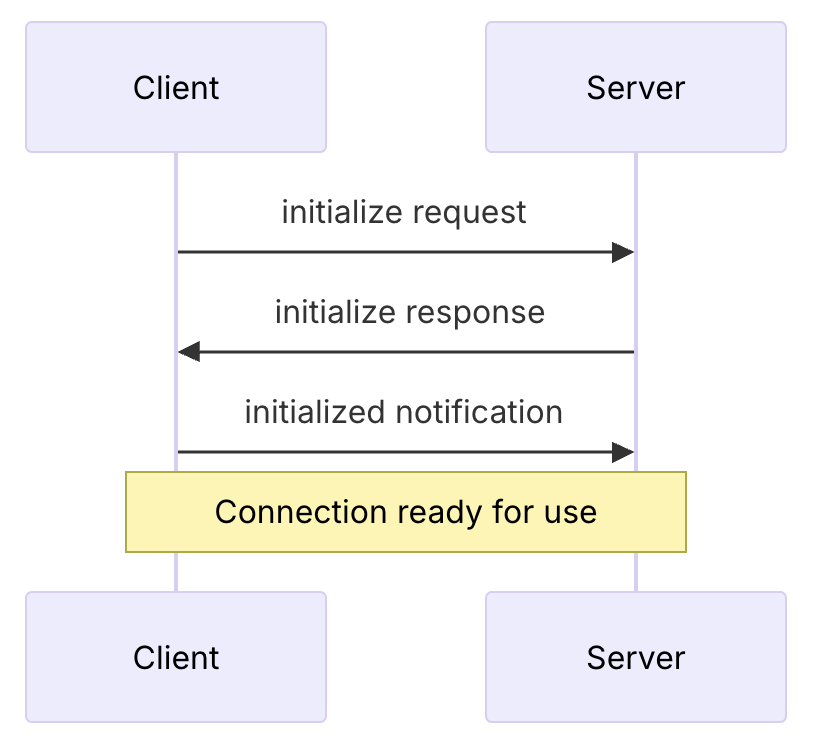
7.2. Message exchange 消息交换
- 客户端或服务器发送请求,另一方响应
- 任一方发送单向消息(Notifications)
7.3. Termination 终止
任何一方均可终止连接
8. MCP 功能类型
MCP 服务器提供三种主要功能类型:
- Tools 工具
- 可以由 LLM 集成的功能
- 常见工具类型
- System operations 系统操作
- 与本地系统交互的工具
- API integrations API 集成
- 封装外部 API 的工具
- Data processing 数据处理
- 转换或分析数据的工具
- System operations 系统操作
- https://modelcontextprotocol.io/docs/concepts/tools#python
- Resources 资源
- 可以由 LLM 读取的任何类型的数据
- 每个资源都由一个唯一的 URI 标识,可以包含文本或二进制数据
- Resource types 资源类型
- Text resources 文本资源
- 文本资源包含 UTF-8 编码的文本数据。这些适用于:
- Source code 源代码
- Configuration files 配置文件
- Log files 日志文件
- JSON/XML data JSON/XML 数据
- Plain text 纯文本
- 文本资源包含 UTF-8 编码的文本数据。这些适用于:
- Binary resources 二进制资源
- 二进制资源包含原始的二进制数据,以 base64 编码。这些资源适用于:
- Images 图片
- PDFs PDF 文件
- Audio files 音频文件
- Video files 视频文件
- Other non-text formats 其他非文本格式
- 二进制资源包含原始的二进制数据,以 base64 编码。这些资源适用于:
- Text resources 文本资源
- https://modelcontextprotocol.io/docs/concepts/resources
- Prompts 提示
- 创建可重用的提示模板和工作流程,帮助用户完成特定任务的预写提示模板
- https://modelcontextprotocol.io/docs/concepts/prompts
两种额外功能:
- Sampling
- MCPServer 调用 MCPClient 的 LLM
- https://modelcontextprotocol.io/docs/concepts/sampling
- Roots
- Roots定义了服务器可以操作的范围
- 比如客户端在服务器上开了个人工作空间,客户端在工作空间中进行操作,告诉服务器它在用这个工作空间
- Roots通常用于定义:
- Project directories 项目目录
- Repository locations 仓库位置
- API endpoints API 端点
- Configuration locations 配置位置
- Resource boundaries 资源边界
- https://modelcontextprotocol.io/docs/concepts/roots
9. 不同功能类型的标准协议
9.1. Resources
Resources URIs 统一资源标识符
- 每个Resource都按以下标准定义
[protocol]://[host]/[path]
9.2. Prompts
Prompt Structure 提示结构
- 每个Prompt都按以下标准定义
{
name: string; // Unique identifier for the prompt
description?: string; // Human-readable description
arguments?: [ // Optional list of arguments
{
name: string; // Argument identifier
description?: string; // Argument description
required?: boolean; // Whether argument is required
}
]
}
9.3. Tools
Tool definition structure 工具定义结构
- 每个 Tool 都按以下标准定义
{
name: string; // Unique identifier for the tool
description?: string; // Human-readable description
inputSchema: { // JSON Schema for the tool's parameters
type: "object",
properties: { ... } // Tool-specific parameters
},
annotations?: { // Optional hints about tool behavior
title?: string; // Human-readable title for the tool
readOnlyHint?: boolean; // If true, the tool does not modify its environment
destructiveHint?: boolean; // If true, the tool may perform destructive updates
idempotentHint?: boolean; // If true, repeated calls with same args have no additional effect
openWorldHint?: boolean; // If true, tool interacts with external entities
}
}
9.4. Sampling
Message format 消息格式
- 服务器发起 Sampling 请求都按以下标准定义
{
messages: [
{
role: "user" | "assistant",
content: {
type: "text" | "image",
// For text:
text?: string,
// For images:
data?: string, // base64 encoded
mimeType?: string
}
}
],
modelPreferences?: {
hints?: [{
name?: string // Suggested model name/family
}],
costPriority?: number, // 0-1, importance of minimizing cost
speedPriority?: number, // 0-1, importance of low latency
intelligencePriority?: number // 0-1, importance of capabilities
},
systemPrompt?: string,
includeContext?: "none" | "thisServer" | "allServers",
temperature?: number,
maxTokens: number,
stopSequences?: string[],
metadata?: Record<string, unknown>
}
Response format 响应格式
- 客户端返回 Sampling 结果都按以下标准定义
{
model: string, // Name of the model used
stopReason?: "endTurn" | "stopSequence" | "maxTokens" | string,
role: "user" | "assistant",
content: {
type: "text" | "image",
text?: string,
data?: string,
mimeType?: string
}
}
10. MCP Client (MCP 客户端)
比较火的MCP客户端
- 适合非工程师
- Claude Desktop App
- Anthropic官方产品,支持MCP的本地工具和数据源集成,适合工程师和非工程师
- https://claude.ai/download
- LibreChat
- 开源聊天应用,支持MCP工具集成
- https://github.com/danny-avila/LibreChat
- Claude Desktop App
- 适合工程师
- Cursor
- AI驱动的代码编辑器,快速采用MCP,适合开发者
- https://www.cursor.com/
- Cline
- 开源VSCode扩展,支持MCP市场和自定义服务器
- https://github.com/cline/cline
- Continue
- VSCode和JetBrains扩展,支持完整的MCP功能
- https://github.com/continuedev/continue
- Zed
- 高性能代码编辑器,支持MCP扩展
- https://zed.dev/
- Windsurf Editor
- AI驱动的代码编辑器,支持MCP协议
- https://windsurf.com/editor
- Sourcegraph Cody
- AI编码助手,支持MCP配置
- https://sourcegraph.com/cody
- Cursor
应用程序集成对 MCP 支持后(也就是作为 MCP 客户端),可为用户提供强大的 AI 上下文能力,方便用户通过 AI 模型与 MCP 服务器进行交互
不同客户端可能支持不同的 MCP 功能,因此与 MCP 服务器的集成程度也有所差异。
| Client | Resources | Prompts | Tools | Sampling | Roots | Notes |
|---|---|---|---|---|---|---|
| Claude Desktop App | ✅ | ✅ | ✅ | ❌ | ❌ | Supports tools, prompts, and resources. |
| LibreChat | ❌ | ❌ | ✅ | ❌ | ❌ | Supports tools for Agents |
| Cursor | ❌ | ❌ | ✅ | ❌ | ❌ | Supports tools. |
| Cline | ✅ | ❌ | ✅ | ❌ | ❌ | Supports tools and resources. |
| Continue | ✅ | ✅ | ✅ | ❌ | ❌ | Supports tools, prompts, and resources. |
| Zed | ❌ | ✅ | ❌ | ❌ | ❌ | Prompts appear as slash commands |
| Windsurf Editor | ❌ | ❌ | ✅ | ❌ | ❌ | Supports tools with AI Flow for collaborative development. |
| Sourcegraph Cody | ✅ | ❌ | ❌ | ❌ | ❌ | Supports resources through OpenCTX |
More:
- 官网提及的客户端列表:https://modelcontextprotocol.io/clients
- PulseMCP提及的客户端列表:https://www.pulsemcp.com/clients
10.1. Cursor 作为 MCP 客户端
Cursor 配置 MCP 的介绍:https://docs.cursor.com/context/model-context-protocol
将 Cursor 连接到外部工具或数据源,代替了用户通过 Prompt 告诉 Cursor 外部的一些情况
示例:
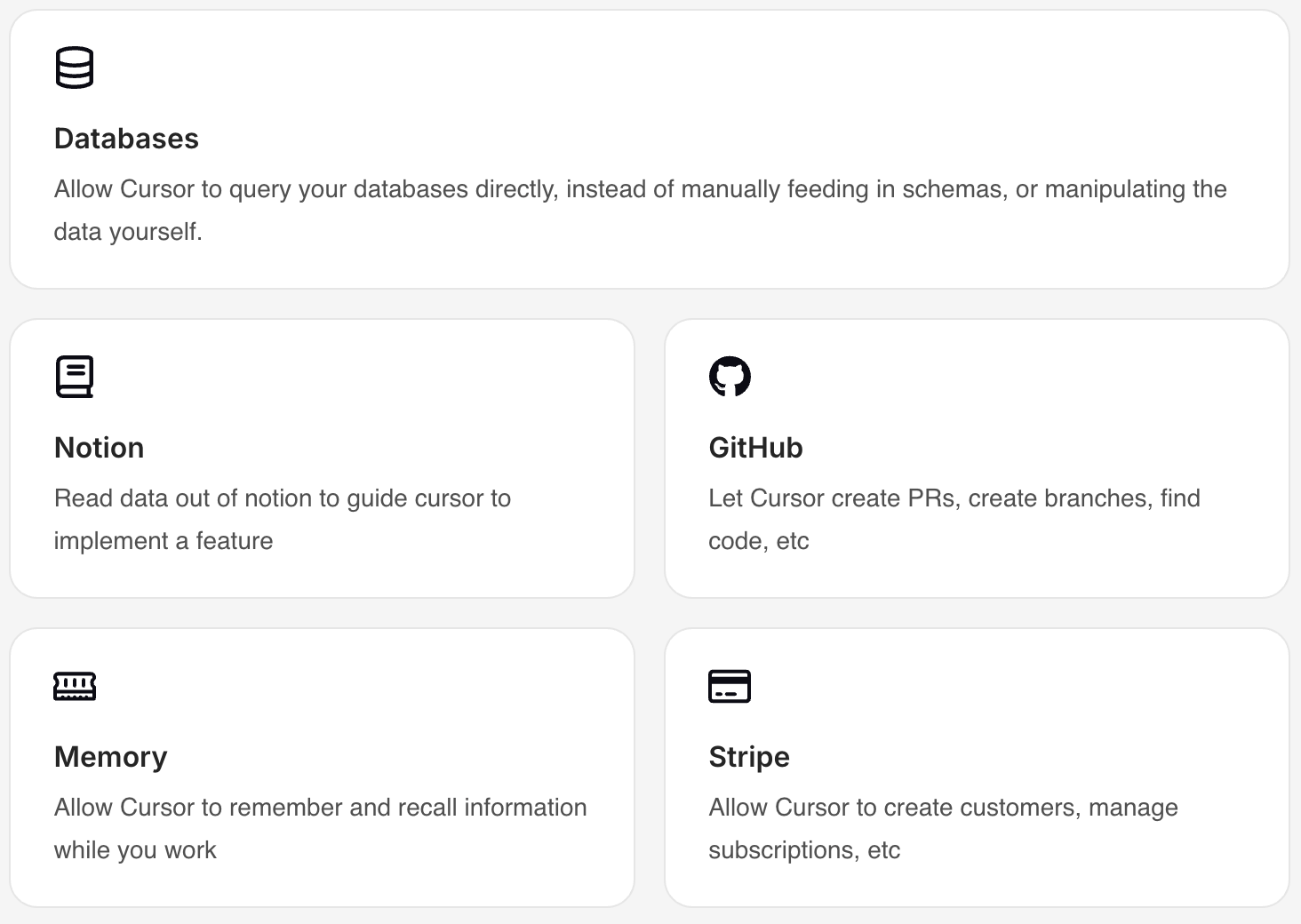
传输机制:
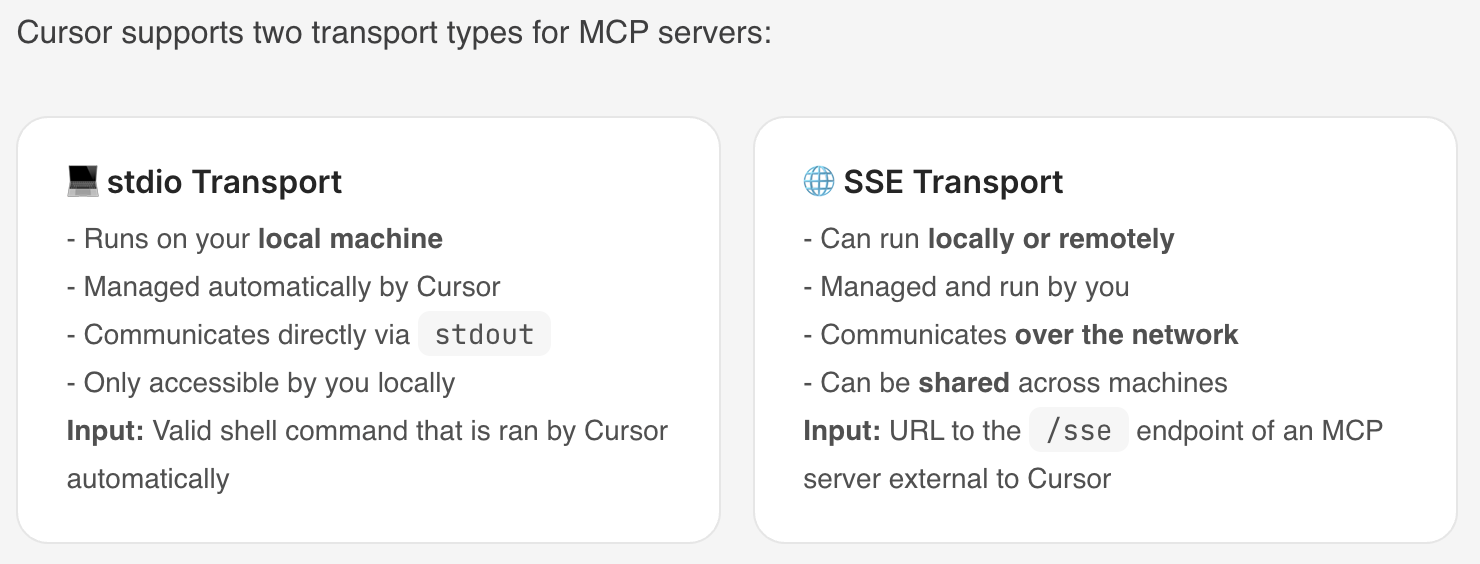
11. MCP Server (MCP 服务器)
- 官方 MCP Servers
- https://github.com/modelcontextprotocol/servers
- https://modelcontextprotocol.io/examples
- Cursor MCP Servers
- https://cursor.directory/mcp
- punkpeye 精选 MCP Servers: https://github.com/punkpeye/awesome-mcp-servers/blob/main/README-zh.md
- Cline的MCP Marketplace
- https://smithery.ai/
- https://www.pulsemcp.com/
- http://glama.ai/mcp/servers
好用的MCP工具
- 数据与文件系统
- Filesystem
- 提供安全的文件操作功能,并且可以配置访问控制权限,确保文件访问的安全性和规范性
- PostgreSQL
- 提供只读数据库访问,具备架构检查功能
- Filesystem
- 开发工具
- GitHub
- 实现仓库管理、文件操作,还集成了 GitHub API,方便与 GitHub 平台进行交互
- Git
- 提供读取、搜索和操作 Git 仓库的工具,帮助开发人员管理代码版本
- GitHub
- 爬虫
- Firecrawl:复制网站
- 网络与浏览器自动化
- Brave Search:利用Brave的搜索API进行网络和本地搜索。
- Fetch:为LLM优化的网络内容获取和转换
- Puppeteer:提供浏览器自动化和网页抓取功能。
- Playwright:控制浏览器
- 可以自动化浏览器任务。填表单,截图,导航网页。还能执行JavaScript,监控控制台日志
- 让LLM和浏览器无缝配合。API测试也变得更简单
12. 不同角色使用 MCP 的方式和逻辑
- MCP Client 用户 (eg. 使用 Claude Desktop App 或 Cursor 的用户)
- 只需在配置中添加要使用的 MCP Server 后,正常问问题就行
- MCP Client 开发者 (eg. Claude Desktop App 或 Cursor的开发者)
- 实例化 MCP 客户端
- MCP 客户端与 MCP 服务器建立连接
- 每当用户发起一个问题,执行以下逻辑(传给LLM的工具列表是和工具调用是由MCP负责的):
- 拼接用户 query 为 messages
- MCP Client 获取可用工具列表 available_tools
- 将 messages 和 available_tools 作为入参调用 LLM
- LLM 响应有两种:text 或 tool_use
- 如果是 text 则将文本结果返回给用户,结束
- 如果是 tool_use
- MCP Client 通过MCP Server执行工具调用
- 得到工具调用结果
- messages 除了用户 query("role": "user")外,接着拼接 LLM 响应("role": "assistant")和工具调用结果("role": "user")为新的 messages
- 将拼接后的 messages 和 available_tools 作为参数再次调用 LLM
- 将 LLM 响应结果返回给用户,结束
- MCP Server 开发者
- 实例化 MCP 服务器
- 定义工具,实现每个工具的执行逻辑
- 运行 MCP 服务器
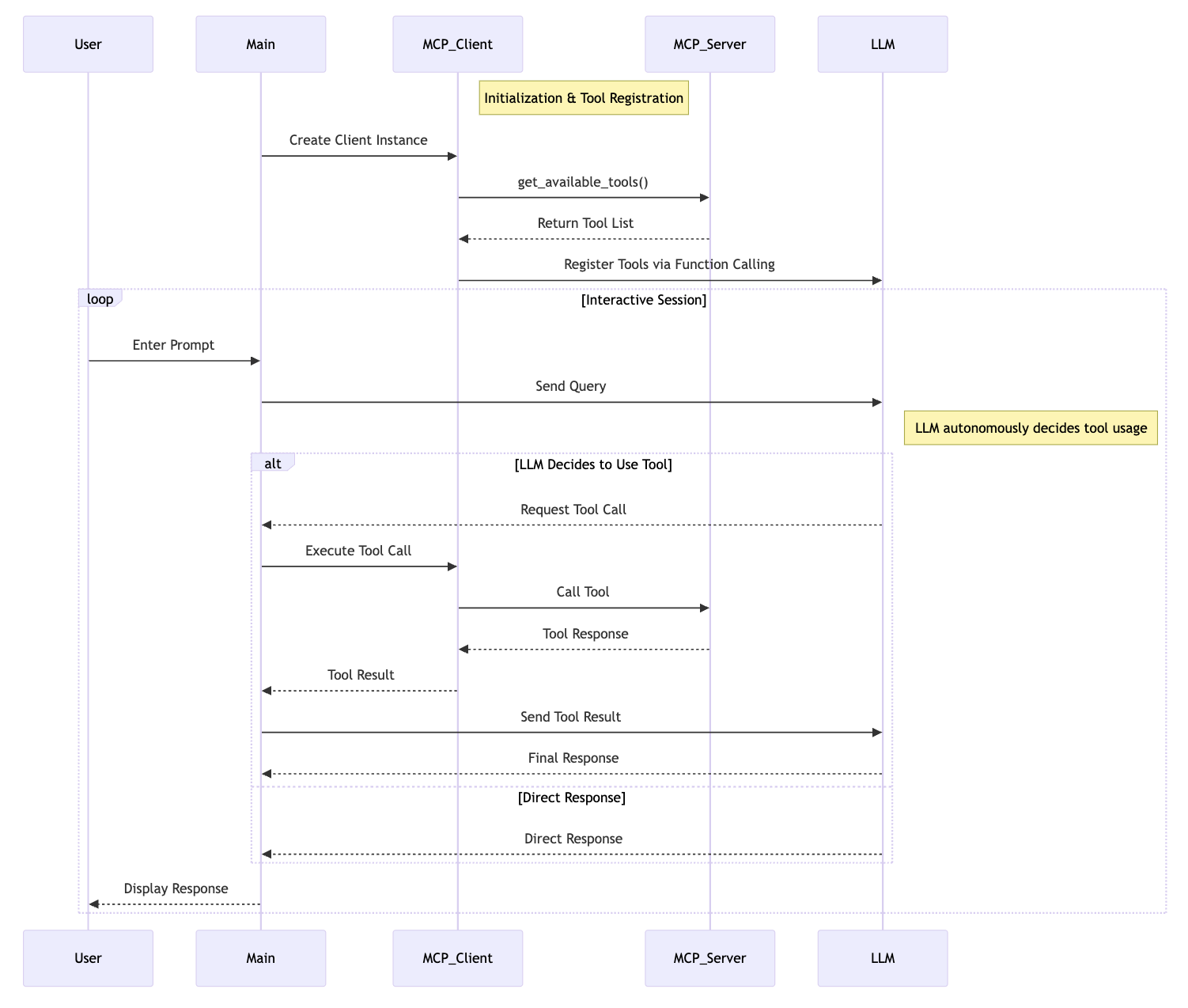
13. MCP Client 用户使用案例(Claude Desktop App)
13.1. 在 Claude Desktop App 中配置想要使用的MCP服务器
在Claude Desktop App 中添加想要使用的 MCP 服务器 "weather" 到 "mcpServers" 配置项
- 告诉 Claude Desktop App 有一个名为 "weather" 的 MCP 服务器
{
"mcpServers": {
"weather": {
"command": "uv",
"args": [
"--directory",
"/ABSOLUTE/PATH/TO/PARENT/FOLDER/weather",
"run",
"weather.py"
]
}
}
}
保存配置后重启Claude Desktop App
13.2. 在 Claude Desktop App 中查看可用工具
可以看到配置的所有服务器提供的所有工具
- 工具名称
- 工具的功能描述
- 工具来源于哪个MCP服务器
13.3. 在 Claude Desktop App 中问一些相关问题
- 用户发起一个问题
- Claude分析可用工具,决定是否使用工具和使用哪个工具
- 如果确定使用MCP工具,该工具对应的MCP Client通过MCP Server执行选中的工具
- 执行结果返回给Claude
- Claude将执行结果转为自然语言响应
- 用户收到响应
14. 构建 MCP 服务器案例
以下代码构建的 MCP 服务器名称为 “weather”,提供了2个工具:get-alerts 和 get-forecast
14.1. 实例化 MCP 服务器
mcp = FastMCP("weather")
14.2. 定义工具,实现每个工具的执行逻辑
- 加上@mcp.tool()后,一个API就是一个MCP工具
- 不需要提供一个查询可用工具列表的API
@mcp.tool()
async def get_alerts(state: str) -> str:
"""Get weather alerts for a US state.
Args:
state: Two-letter US state code (e.g. CA, NY)
"""
pass
@mcp.tool()
async def get_forecast(latitude: float, longitude: float) -> str:
"""Get weather forecast for a location.
Args:
latitude: Latitude of the location
longitude: Longitude of the location
"""
pass
14.3. 运行 MCP 服务器
mcp.run(transport='stdio')
15. 构建 MCP 客户端案例
15.1. 创建 .env 文件
设置Anthropic API key
ANTHROPIC_API_KEY=<your key here>
15.2. 定义 MCPClient 类
load_dotenv() # load environment variables from .env
class MCPClient:
def __init__(self):
# Initialize session and client objects
self.session: Optional[ClientSession] = None
self.exit_stack = AsyncExitStack()
self.anthropic = Anthropic()
# methods will go here
15.3. 实现服务器连接管理函数 connect_to_server
async def connect_to_server(self, server_script_path: str):
"""Connect to an MCP server
Args:
server_script_path: Path to the server script (.py or .js)
"""
is_python = server_script_path.endswith('.py')
is_js = server_script_path.endswith('.js')
if not (is_python or is_js):
raise ValueError("Server script must be a .py or .js file")
command = "python" if is_python else "node"
server_params = StdioServerParameters(
command=command,
args=[server_script_path],
env=None
)
stdio_transport = await self.exit_stack.enter_async_context(stdio_client(server_params))
self.stdio, self.write = stdio_transport
self.session = await self.exit_stack.enter_async_context(ClientSession(self.stdio, self.write))
await self.session.initialize()
# List available tools
response = await self.session.list_tools()
tools = response.tools
print("\nConnected to server with tools:", [tool.name for tool in tools])
15.4. 实现处理查询和工具调用的函数 process_query
async def process_query(self, query: str) -> str:
"""Process a query using Claude and available tools"""
messages = [
{
"role": "user",
"content": query
}
]
response = await self.session.list_tools()
available_tools = [{
"name": tool.name,
"description": tool.description,
"input_schema": tool.inputSchema
} for tool in response.tools]
# Initial Claude API call
response = self.anthropic.messages.create(
model="claude-3-5-sonnet-20241022",
max_tokens=1000,
messages=messages,
tools=available_tools
)
# Process response and handle tool calls
final_text = []
assistant_message_content = []
for content in response.content:
if content.type == 'text':
final_text.append(content.text)
assistant_message_content.append(content)
elif content.type == 'tool_use':
tool_name = content.name
tool_args = content.input
# Execute tool call
result = await self.session.call_tool(tool_name, tool_args)
final_text.append(f"[Calling tool {tool_name} with args {tool_args}]")
assistant_message_content.append(content)
messages.append({
"role": "assistant",
"content": assistant_message_content
})
messages.append({
"role": "user",
"content": [
{
"type": "tool_result",
"tool_use_id": content.id,
"content": result.content
}
]
})
# Get next response from Claude
response = self.anthropic.messages.create(
model="claude-3-5-sonnet-20241022",
max_tokens=1000,
messages=messages,
tools=available_tools
)
final_text.append(response.content[0].text)
return "\n".join(final_text)
15.5. 定义 chat_loop 和 cleanup 函数
async def chat_loop(self):
"""Run an interactive chat loop"""
print("\nMCP Client Started!")
print("Type your queries or 'quit' to exit.")
while True:
try:
query = input("\nQuery: ").strip()
if query.lower() == 'quit':
break
response = await self.process_query(query)
print("\n" + response)
except Exception as e:
print(f"\nError: {str(e)}")
async def cleanup(self):
"""Clean up resources"""
await self.exit_stack.aclose()
15.6. 主入口
async def main():
if len(sys.argv) < 2:
print("Usage: python client.py <path_to_server_script>")
sys.exit(1)
client = MCPClient()
try:
await client.connect_to_server(sys.argv[1])
await client.chat_loop()
finally:
await client.cleanup()
if __name__ == "__main__":
import sys
asyncio.run(main())
